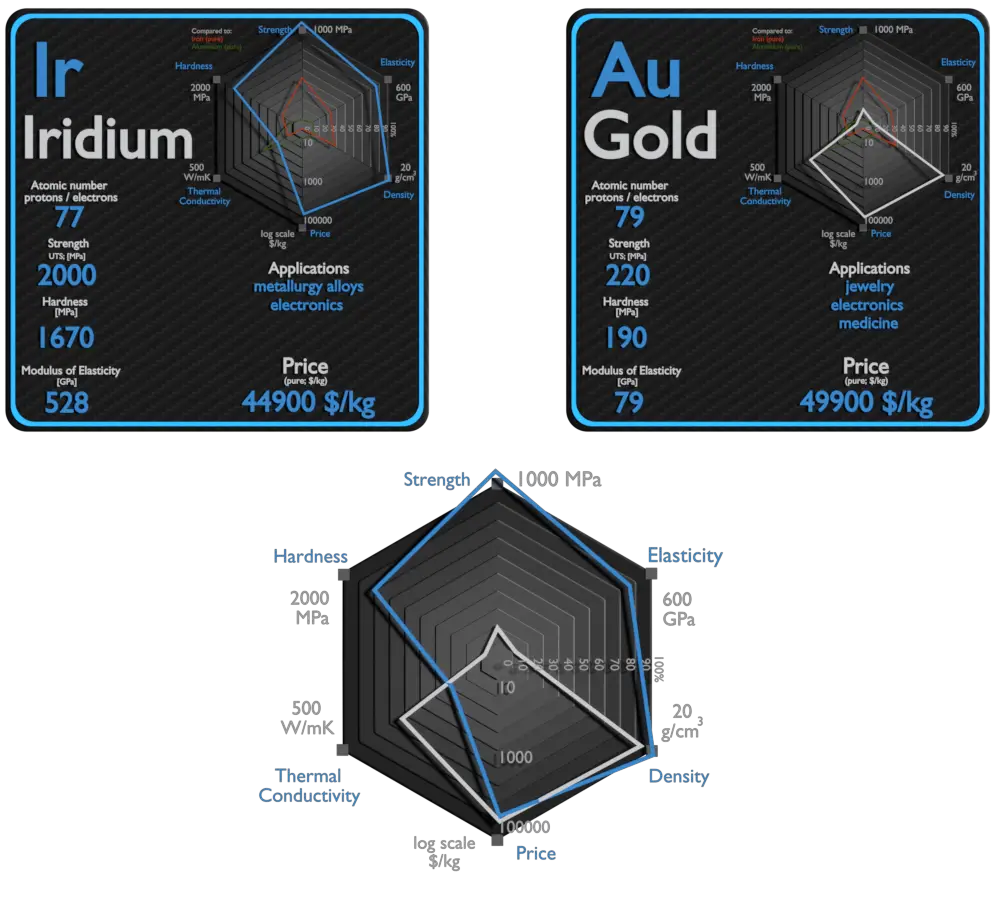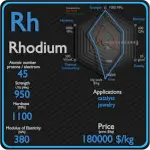This article contains comparison of key thermal and atomic properties of iridium and gold, two comparable chemical elements from the periodic table. It also contains basic descriptions and applications of both elements. Iridium vs Gold.

Iridium and Gold – About Elements


Source: www.luciteria.com
Iridium and Gold – Applications
Iridium
Iridium is mainly consumed by the automotive, electronic, and chemical industries. Iridium metal is employed when high corrosion resistance at high temperatures is needed, as in high-performance spark plugs, crucibles for recrystallization of semiconductors at high temperatures, and electrodes for the production of chlorine in the chloralkali process. The demand for iridium surged from 2.5 tonnes in 2009 to 10.4 tonnes in 2010, mostly because of electronics-related applications that saw a rise from 0.2 to 6 tonnes – iridium crucibles are commonly used for growing large high-quality single crystals, demand for which has increased sharply.
Gold
Gold is used extensively in jewellery, either in its pure form or as an alloy. About 75% of all gold produced is used in the jewelry industry. Pure gold is too soft to stand up to the stresses applied to many jewelry items. Craftsmen learned that alloying gold with other metals such as copper, silver, and platinum would increase its durability. The term ‘carat’ indicates the amount of gold present in an alloy. 24-carat is pure gold, but it is very soft. 18- and 9-carat gold alloys are commonly used because they are more durable. Gold’s high malleability, ductility, resistance to corrosion and most other chemical reactions, and conductivity of electricity have led to its continued use in corrosion resistant electrical connectors in all types of computerized devices (its chief industrial use). Gold is also used in infrared shielding, colored-glass production, gold leafing, and tooth restoration. Only 10% of the world consumption of new gold produced goes to industry, but by far the most important industrial use for new gold is in fabrication of corrosion-free electrical connectors in computers and other electrical devices.
Iridium and Gold – Comparison in Table
| Element | Iridium | Gold |
| Density | 22.65 g/cm3 | 19.3 g/cm3 |
| Ultimate Tensile Strength | 2000 MPa | 220 MPa |
| Yield Strength | N/A | 205 MPa |
| Young’s Modulus of Elasticity | 528 GPa | 79 GPa |
| Mohs Scale | 6.25 | 2.75 |
| Brinell Hardness | 1670 MPa | 190 MPa |
| Vickers Hardness | 1760 MPa | 215 MPa |
| Melting Point | 2410 °C | 1064 °C |
| Boiling Point | 4130 °C | 2970 °C |
| Thermal Conductivity | 150 W/mK | 320 W/mK |
| Thermal Expansion Coefficient | 6.4 µm/mK | 14.2 µm/mK |
| Specific Heat | 0.13 J/g K | 0.128 J/g K |
| Heat of Fusion | 26.1 kJ/mol | 12.55 kJ/mol |
| Heat of Vaporization | 604 kJ/mol | 334.4 kJ/mol |












